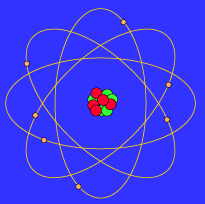Ionic compound
The simplest type of oxidation-reduction (coupled) reactions is that which occurs between metals and nonmetals of the Representative Elements. The transfer of electrons between the atoms of these elements result in drastic changes to the elements involved. This is due to the formation of ionic compounds. The reaction between sodium and chlorine serves as a typical example. The element sodium is a rather "soft" metal solid, with a silver-grey color. Chlorine is greenish colored gas. When a single electron is transferred between these elements, their atoms are transformed via a violent reaction into a totally different substance called, sodium chloride, commonly called table salt -- a white, crystalline, and brittle solid.
Sodium chloride exhibits properties quite distinct and different from sodium and chlorine. The changes in physical as well as chemical properties are due to the formation of cations and anions via the oxidation-reduction process, and the resultant, powerful attractive force that develops between these oppositely charge ions. This force of attraction is called the ionic or electrostatic bond, and serves to keep the sodium and chloride ions tightly bound in a highly organized network or lattice of alternating positive and negative charges. This entire complex of ions is called an ionic compound, and is illustrated below in two dimensions. Note how the oppositely charged ions are arranged.
skip to main |
skip to sidebar


Bhor's atom model
Oxidation reduction reaction.
Search

Custom Search
How is this blog?
Blog Archive
-
▼
2009
(24)
-
▼
August
(24)
- Oxidation Reduction
- Oxidation states
- Definition of oxidation reduction
- Ionic compound
- Ionic formulas
- Electronegativity
- Electronegativity & Metal/Nonmetal CompoundsAs ind...
- Redox Reactions Involving Nonmetals OnlyThe situat...
- Guidelines - Oxidation States of Nonmetals1. When ...
- Types of redox reaction.
- Combination reactions
- Decomposition reactions
- Single displacement reactions
- Balancing Redox Reactions Using the Half Reaction ...
- Balancing Redox Reactions in Basic Solutions
- Bleaching Agents (Application of redox reaction)
- Photosynthesis (Application of redox reaction)
- Metabolism (Application of redox reaction)
- Nitrogen Fixation(Application of redox reaction)
- Combustion of Fuels (Application of redox reaction)
- The "Dry-Cell" Battery
- Electrochemical Cells (Application of redox reaction)
- Photo-oxidation - Photochromic Glass (Application ...
- Corrosion (Application of redox reaction)
-
▼
August
(24)
Labels
- . single displacement reactions (1)
- balancing redox reactions in basic solutions (1)
- balancing redox reactions using the half reaction method (1)
- bleaching agents (1)
- combination reaction (1)
- combustion of fuels (1)
- corrosion (1)
- decomposition reactions (1)
- definition of oxidation reduction (1)
- electrochemical cells (1)
- electronegativity (2)
- ionic compound (1)
- ionic formula (1)
- metabolism (1)
- nitrogen fixation (1)
- oxidation number (2)
- oxidation reduction (1)
- Photo-oxidation - Photochromic Glass (1)
- photosynthesis (1)
- redox reactions (1)
- the "Dry-Cell" battery (1)
- Types of redox reaction (1)
Image

Bhor's atom model

No comments:
Post a Comment